|
Health Watch
Getting rid of the patient or sickness
Nadira Gunatilleke
Last week you read how a patient consults (channel) a doctor, goes to
the hospital and meets him. But the story did not end there. There is
more to come. This is not the story of one or two persons in Sri Lanka.
This is the story of almost all the upper and lower middle class Sri
Lankans.
 You
channel a doctor after waiting in a queue for many hours in the dawn
then go home and turn up in the day of the appointment. This is what
many of us experience after entering into the consultation room. You
channel a doctor after waiting in a queue for many hours in the dawn
then go home and turn up in the day of the appointment. This is what
many of us experience after entering into the consultation room.
Now the patient who held number one enters into the consultation
room! The doctor was already scribbling something on a paper. It is not
just a paper, may be the letter head of the respective hospital. It is
your prescription and you are still on the door step of the room! Do you
think the doctor has some sort of super power to see through (scan) your
body or read your mind? No.
He or she is an ordinary doctor without any of those powers but they
write a prescription for you even before you finish explaining your
symptoms! This is not the story when it comes to all the doctors. There
are many doctors who limit the number of appointments to allocate
adequate time for each patients and listen to the patient very carefully
while asking many questions.
The behaviour of some ‘nurses’ who assist doctors make patients more
sick! Those nurses’ (they are just assistants and hardly can call them
nurses) main objective is getting rid of the patient from the room as
soon as possible.
Sometimes she forgets that she is handling a patient! She is that
much impatient and quick. Sometimes the nurse does not wait till the
patient get himself/herself dressed up after an examination. Sometimes
few more patients are taken in at once, completely violating the privacy
of the patient. This deadly rush does not do any good to patients
although it help nurses and doctors in every way.
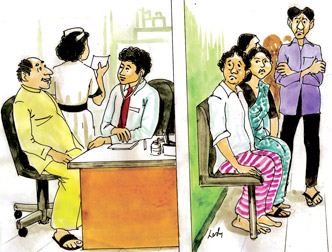
Number 48 or 49 face the most pathetic situation. Now the doctor is
very tired after examining over 45 patients during few hours.
He or she has to visit several other hospitals for consultation. This
is the time the doctor’s tiredness and anger is released on the patient.
The most dangerous thing happens at this time. It is the doctor
prescribing medicine for depression instead of your actual sickness!
What if you do not know the names of the drugs and do not know the
drug is prescribed for depression? You are very lucky if you know which
drug is prescribed for which sickness (the brand/generic names and
contents of drugs). You are lucky if you know the effects of the drugs
prescribed for depression. You are lucky if you decide to go for a
second opinion before starting the drugs. Then you can be saved by your
CTC or MRI scan report!
Sometimes the most experienced and qualified pharmacists cannot read
the doctor’s prescription because only a scribbling is there. In such
instances some pharmacists do not issue the drug and say that he or she
cannot read it. Sometimes pharmacists say the drug is not available
which is not true. Sometimes they question the patient about his/her
sickness and guess the name of the drug and issue it! Sometimes the poor
patient is forced to see the doctor again. If the patient cannot turn up
with the relevant reports within one week, he or she has to pay money
again and channel the doctor for the second time just to show the
reports.
Another pathetic experience described by some patients who underwent
operations in private hospital - not taking them for the operation on
time.
Undergoing an operation is a challenge for a patient and he/she is
under lot of pressure before and after the operation. This unnecessary
waiting period adds more pressure to the patient. According to one
female patient who underwent a surgery to get some fibroids removed from
her womb said that she waited more than three hours on a stretcher
before the operation. She was taken for the operation only after she
fell asleep on the stretcher on an empty tummy. She did not want to
describe the ordeal she faced after the operation. What we cannot
understand is why the hospital management and the relevant doctor can’t
plan operations and do time management.
The most pathetic situation is only ordinary patients undergo all
those hardships described here and last week. No powerful or well
connected patients undergo any of those hardships. All what they need to
do is dial the doctor’s mobile number and inform the doctor that he or
she is out there close to the channeling room.
The next moment the powerful patient is allowed to go in. Once they
are in, the patient takes a long time because the doctor has time to
talk casual things (completely irrelevant things to his or her sickness)
with the patient.
What happens to the 45 ordinary patients waiting outside? Doctors and
nurses are there to get rid of the sickness of the patient and not the
patients themselves!
Food poisoning
Day to day problem:
Food poisoning is something that bother us in our day to day life. It
can be happen to anyone at anytime, no matter from where you eat and
what you eat. Therefore it is important to learn the main facts on this
issue. You can help yourself and your loved ones by learning certain
important facts.
 Food
poisoning is an illness resulting from the consumption of contaminated
food. There are two types of food poisoning: infectious agent and toxic
agent. Food infection refers to the presence of bacteria or other
microbes which infect the body after consumption. Food intoxication
refers to the ingestion of toxins contained within the food, including
bacterially produced exotoxins, which can happen even when the microbe
that produced the toxin is no longer present or able to cause infection. Food
poisoning is an illness resulting from the consumption of contaminated
food. There are two types of food poisoning: infectious agent and toxic
agent. Food infection refers to the presence of bacteria or other
microbes which infect the body after consumption. Food intoxication
refers to the ingestion of toxins contained within the food, including
bacterially produced exotoxins, which can happen even when the microbe
that produced the toxin is no longer present or able to cause infection.
In spite of the common term food poisoning, most cases are caused by
a variety of pathogenic bacteria, viruses, or parasites that contaminate
food, rather than chemical or natural toxins.

Symptoms typically begin several hours to several days after
consumption and depending on the agent involved, can include one or more
of the following: nausea, abdominal pain, vomiting, diarrhea,
gastroenteritis, fever, headache or fatigue.
In most cases the body is able to permanently recover after a short
period of acute discomfort and illness. However, food borne illness can
result in permanent health problems or even death, especially for people
at high risk, including babies, young children, pregnant women (and
their fetuses), elderly people, sick people and others with weak immune
systems.
Food borne illness due to campylobacter, yersinia, salmonella or
shigella infection is a major cause of reactive arthritis, which
typically occurs 1–3 weeks after diarrheal illness. Similarly, people
with liver disease are especially susceptible to infections from Vibrio
vulnificus, which can be found in oysters or crabs.
Tetrodotoxin poisoning from reef fish and other animals manifests
rapidly as numbness and shortness of breath, and is often fatal.
Wikipedia
Rush in life
Rush to a chronic disease:
Dr. Indira Samarawickrema MBBS MSc MD Consultant
Community Physician
Poor lifestyle choices bring about the chronic diseases such as
hypertension (high blood pressure), type 2 diabetes and other diseases.
Risk factors
There are risk factors for these chronic diseases which are
modifiable and non-modifiable. There is also a group of risk factors
which cannot be changed. These non-modifiable risk factors include age,
gender, family history, genetic makeup and ethnicity.
Modifiable
risk factors
* Tobacco smoking
* Alcohol misuse
* Excess weight
* Physical inactivity
* Poor diet and nutrition
* High blood pressure
* High blood cholesterol
Non-modifiable risk factors
* Age
* Gender
* Family history
* Genetic makeup
* Ethnicity |
Tobacco smoking and alcohol misuse are factors which you could easily
answer Yes or No.

How do we know whether we have excess weight or not? You could
measure weight and check your height and determine the body mass index.
This calculation helps determine whether you are overweight or not.
Body mass index (BMI) below 25kg/m2 is considered normal. BMI between
25 kg/m2 and 30kg/m2 is considered overweight and over 30kg/m2 is
considered obese. These cut-off points are applicable to persons over 18
years in age.
Now you know what your BMI is and whether you are in the normal range
or overweight or obese. BMI may underestimate body fat in those with
less muscle bulk as in older persons or high muscle bulk as in athletes.
As a result, an older person may have a low BMI despite high body fat.
An athlete may have a high BMI due to the higher muscle bulk despite
having less body fat.
Waist measurement - a simple tool to determine the risk.
The area where we have more fat deposited can indicate whether we are
at the risk of developing a chronic disease. Waist measurement is a
simple measurement which indicates the abdominal fat deposition. High
waist measurement tells us whether we are at risk of developing chronic
disease such as high blood pressure, high cholesterol, heart disease and
type 2 diabetes.
We can measure the waist circumference with a flexible measuring
tape. Here are the steps in measuring the waist correctly.
Women
Healthy: Less than 80 cm
At risk: More than 80 cm
Greater risk: More than 88 cm
Men
Healthy: Less than 90 cm
At risk: More than 90 cm
Greater risk: More than 102 cm |
1.Keep a flexible measuring tape.
2.Remove the clothes from around the waist.
3.Stand erect with abdomen relaxed, arms relaxed by the sides and
feet about 12 inches apart.
4.Find the upper ridge of the hip bone on the side of your body and
the lower end of the rib cage.
5.Locate the mid-point between the upper ridge of the hip bone and
the lower end of the rib cage.
6.Keep the tape at this level and take it horizontally around the
abdomen, irrespective whether it is above or below the umbilicus
(navel).
7.Breathe in and out slowly. Now take the measurement.
The measurement should be below 90cm for men and below 80cm for
women.
Trinitian wins first prize
Medical Crossword Draw No. 42:
|
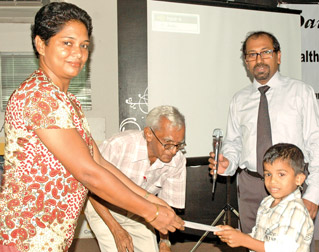
Crossword No. 41 winner MD Poulier receiving her cheque from
little Pumal Jayalath. |
|
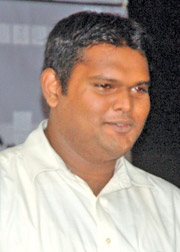
Final year under graduate of the Colombo University H K
Dissanayake who won the third prize in Crossword No. 41
commending the Healthwatch. |
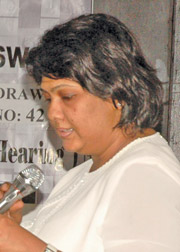
WISH audiologist Preethi Pieris commending the Healthwatch
medical Crossword for the role it plays in educating the public
on health. Pictures by Sudath Nishantha |
An 18 year student of Trinity College Kandy J. C. Samarasekera from
Mahiyawa won first place in the Healthwatch Medical Crossword No. 42
draw. The draw was part of the Wickremarachchi Institute of Speech and
Hearing (WISH) health education program for the hearing affected in
meeting their defect, with the latest hearing aid implants in the
cochlea group from Australia. The draw was conducted by WISH Audiologist
Preethi Pieris, and the Institute head Mihiri Wickremarachchi.
Audiologist Preethi commended Daily News for use of the normal
Crossword educating the public about health by starting a Medical
Crossword in the Daily News Healthwatch in association with the WISH
Institute.
Medical Crossword Coordinator Edward Arambawela on behalf of the
Daily News Editorial and the Healthwatch page, thanked all those present
at the Crossword draw. Altogether 102 had sent entries for draw No. 42
out of which only 58 were correct entries.
Student entries
There were five correct entries from students. Four undergraduates,
and one from Trinity College who won first place. Preethi while thanking
Daily News for getting WISH Institute to sponsor the Medical Crossword
feature said that since they started sponsoring from Crossword No. 30.
She had seen more than twenty percent increase in the entries sent by
the Daily News readers, which showed that the new health education
feature was getting more and more popular, and building up health
education of the public, the old and the young.
First prize Rs. 3,000 – Entry No. 8 J. C. Samarasekera, 18 yrs –
Student at
|

Pumal Jayalath who recently underwent a Baha implant operation
for a hearing defect, picked the Crossword No. 42 winner. |
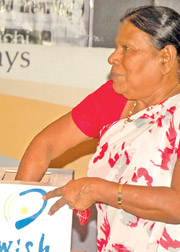
Colombo YMCA Women’s Auxilliary Committee Member Marina Fernando
picking a prize winner in crossword No. 42. |
Trinity College, Kandy.
Second prize – Rs. 2,000 – Entry No. 14 M. S. Kuruban 68 yrs No.
10,Palmyrah Avenue, Colombo 3.
Third prize – Rs. 1,000 – Entry No. 3. V. Rajapakse 78 yrs 251,
Wattaratenne Rd, Kandy.
Consolation prizes of Rs. 500 were won by Mrs. R. Embarrassing 82 yrs
Negombo, Mrs. Abdul Gaffar 67 yrs Colombo 6 and Shanika Dilrukshi 27 yrs
Kakapalliya. The Crossword grid composer Dr. Kelum Palpola congratulate
all the winners. Correct Solution
Across: (2) Auditory (4) Vital (7)
Dengue
(8) Monocyte (10) Sun (1) Fever
(12) Calorie (13) Immune (17) Celsius
(18) Audiology (19) Hypothalamus
Down
(1) Virus (3) Rest (5) Depression
(6) Coughing (9) ENT (10) Soccer
(14) Media (15) Cochlea (16) Mouth
New technique to treat lung cancer
Dr Srinivas Chilukuri
Lung cancer is potentially fatal if left untreated is a well known
fact. But the major problem in treating it through radiation is the
constant movement of the organ as it is difficult to target the tumour.
There are chances of healthy parts being hit by the radiation.
Thus far in India, the best procedure to treat lung cancer has been
surgery. But, as we all know any surgical intervention is not without
complications and suffering. With advancement in technology, lung cancer
patients in India can have access to what is called 4D-Gated
Stereotactic Body Radiosurgery. Lung cancer is the single most
devastating cause of cancer related deaths with approximately 1.5
million cases reported world wide and more than 1.3 million deaths in a
year.
In India, lung cancer constitutes 14.4 percent (1 in 7) of all
cancers as per Indian Council of Medical Research.
Its incidence is rising among both men and women, and increasing
numbers are being detected due to better screening and public awareness.
Radiotherapy and surgery are two major curative modalities in the
treatment of lung cancer with chemotherapy reserved for advanced cases.
Conventional radiotherapy techniques are delivered over 25 to 30
sessions. The new method of radio surgery is completely non-invasive and
it involves delivering the full dose of radiation in as little as one to
three treatments of 10 minutes each.
Instead of five to six weeks, the patient’s treatment can be
completed in just one week. The new method of radio surgery is superior
to conventional radiation therapy and equivalent to surgery. Radio
surgery might become an alternative to invasive surgery in the near
future. |



